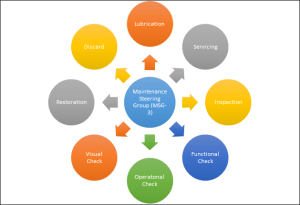The reader will undoubtedly know, that the Approved Maintenance Programme or AMP, resembles a ‘bible’ of ‘Task Orientated’ aircraft maintenance around the eight tasks as required under MSG-3 (See opposite), with these tasks then categorized into three distinct areas:
- Aircraft Systems
- Structural Items
- Zonal
All regulators require some form of Continuing Analysis & Surveillance of the AMP in order to ensure the AMP remains in in context of the airline’s operation not least, an effective maintenance document.
For most operators of Commercial Air Transport (CAT) aircraft this usually refers to the establishment of both a Quality Assurance and Reliability Programme. Although Quality Assurance is an equally important element of AMP reliability, this blog only refers to the importance of reliability data and its intrinsic relationship with the AMP as the primary tool, demonstrating evidence of AMP effectiveness.
The Importance of the Reliability Programme
• Regulatory Compliance;
• Increased Aircraft Availability;
• Optimized Maintenance Best practice through elimination of redundant or ineffective tasks &/or procedures.
• Reduction in the number of ‘No-fault-found’ occurrences;
• Reduction in long-term Fleet Maintenance Costs;
• Uptime optimization through reduction in maintenance downtime.
It is the essential decision-making tool for the operators CAMO by providing summarized fleet reliability data from which maintenance programme implementation & effectiveness conclusions can be drawn, and (if necessary) acted upon with regard to the real causes of recurrent failure, planning issues, scheduling conflicts and other procedural difficulties.
Once these issues are identified then the operator can engage in a programme of improvement in aircraft fleet reliability through changes to the maintenance program or to the practices for implementing it.
The overall result of an effective reliability program is the better utilization of the available resources.
Reliability Programme Metrics – What are they trying to tell us?
Ultimately, without a fleet of available aircraft, an airline operation becomes increasingly unviable. Therefore, the overall health of an operators’ fleet is demonstrated via key performance parameters including (but not limited to):
• Aircraft Availability
• Despatch / technical dispatch reliability
• Aircraft Structural / System / Component reliability
• Level & degree of Pireps & Mareps reporting
• Aircraft Engine / APU Reliability reporting
• ETOPS (if Applicable)
• etc.
All of the parameters listed above will be measured in association with an Upper Control Limit or an Alert Level which is usually determined via statistical analysis and the introduction of Standard deviation.
The overall concept of alert-levels is to flag issues of failing performance to reliability and ultimately CAMO engineers.
This triggers the process of investigation, corrective action and on-going oversight of these enhancements as a part of the operator’s demonstration of AMP effectiveness.
Conclusion
This blog demonstrates that with the introduction and importance placed on Task-orientated maintenance, Aviation Reliability Systems are no longer a nice to have, but a need to have.
Putting aside the regulatory requirements – financial, commercial and above all, safety obligations justify the need for and effective AMP. Therefore, the presence of a well-designed and well-implemented reliability programme is not only a technical necessity, but also serves to demonstrate operator successes at all levels, not just engineering and maintenance.
Rustom D. Sutaria – Avia Intelligence, Dubai, 2016
Join Rus Sutaria in the Middle East where he will be speaking at great depth about Reliability between 23rd and 26th January 2017.
See details of the Training Session in Dubai, UAE
For details and enquires please email office@sassofia.com




